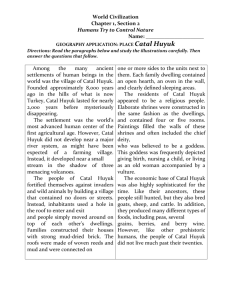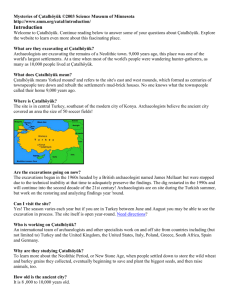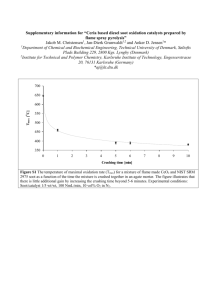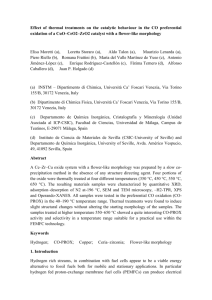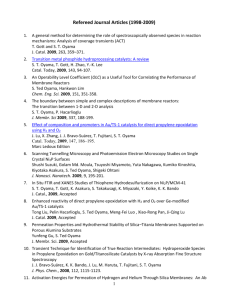Catal Huyuk
advertisement
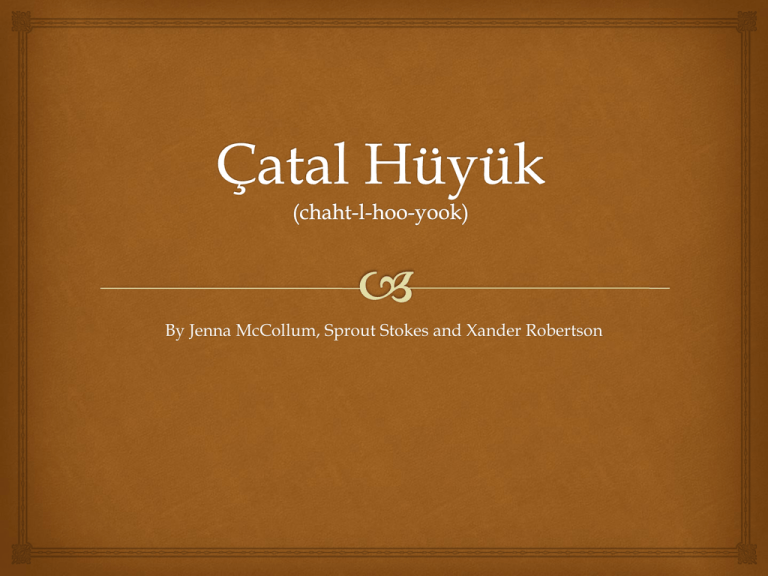
By Jenna McCollum, Sprout Stokes and Xander Robertson City layout All of the houses were built right next to each other. There were no roads. All transit between buildings was by roof. There were small courtyards for housing animals. Roofs were staggered to let light in through windows. Architecture Had an average floor area of 25m or about 280² ft. Made from dried mud the houses typically had a central living room area and then a smaller storeroom at one end. A hearth used for cooking and heating sat against one wall of the structure. Over time as some houses fell apart the materials were reused to build new structures Windows were made in the upper section of walls Architecture A hole in the ceiling on the south side of the building acted as an entrance and exit and was accessible by ladder The hole doubles as a smoke release for the hearth. Çatal Hüyük is in Turkey approximately 40 km Southeast of Konya. Location Discovery The site was first discovered and excavated by James Mellart, a British archaeologist and author, in November 1958 Excavation of the site was delayed by the theft of recovered artifacts. Serious research and re-excavation was resumed in September 1993 by Ian Hodder, another British archaeologist. The 90%of the bones found at the site are from cows. Tools The Çatal Hüyük people had very advanced tools for this point in time such as obsidian and flint spear heads and beads with extremely precise holes drilled in them The Çatal Hüyük had the knowledge of smelting metals such as led and copper. Tools Chipped Stone tools were made by chipping a piece of stone to make a sharp edge or point Ground Stone Ground stone tools were made by tapping one stone against another to make a smooth surface. Age and Population Age Çatal Hüyük is between 8,000 to 10,000 years old It is from the Neolithic period (new stone age) Çatal Hüyük was occupied for about 1,400 years One of the Largest and oldest cities discovered from pre to ancient history and dates back to 7500 BCE Population The population is estimated to be about 10,000 inhabitants at its peak. Destruction of the City A large catastrophic fire is responsible for the destruction of the city as well as the preservation of it. The fire hardened the clay walls, preventing them from too much deterioration over the years. Questions? Bibliography Symcox, Linda. The Neolithic Revolution: The First Farmers and Shepherds. Los Angeles: University of California, 1991. Miller, Brandon. Catal Huyuk: origins of Civilizations. Alternative Archaeology. Web. 19 September 2013.http://alternativearchaeology.jigsy.com/catal-huyuk Mysteries of Çatal Hüyük. Science Museum of Minnesota.2003. web. 20 September 2013.http://www.smm.org/catal/top.php History of Excavations. Catalhoyok Excavations of a Neolithic Anatolian Hoyuk. 2005. web. 19 September 2013. Bibliography(Pictures) GROUND STONE TOOLS. N.d. Photograph. Science Museum of Minnesota. Mysteries of Catal Hoyuk. 2003. Web. 22 Sept. 2013. http://www.smm.org/catal/artifacts/ground_stone_tools/ Obsidian. 1997. Photograph. Science Museum of Minnesota. Mysteries of Catalhoyuk. 2003. Web. 22 Sept. 2013. http://www.smm.org/catal/artifacts/obsidian/ Catal Huyuk. N.d. Proyectso I. Angel Blancos Ramos, 4 Sept. 2011. Web. 20 Sept. 2013. http://blancoramosangel.blogspot.com/search?q=catal+huyuk Catal Huyuk. N.d. Web. Humanties Blog 8 (sophia). Blogspot, 9 Feb. 2011. Web. 22 Sept. 2013. http://sophiaslaura.blogspot.com/2011/02/why-is-catal-hyukimportant.html N.d. Photograph. Mysteries of ÇatalHöyük. Science Museum of Minnesota, 2003. Web. 18 Sept. 2013. <http://www.smm.org/catal/introduction/>. N.d. Photograph. Çatalhöyük Visual Assemblage. University of Southampton, 10 Nov. 2009. Web. 20 Sept. 2013. <http://catalva.wordpress.com/>.


